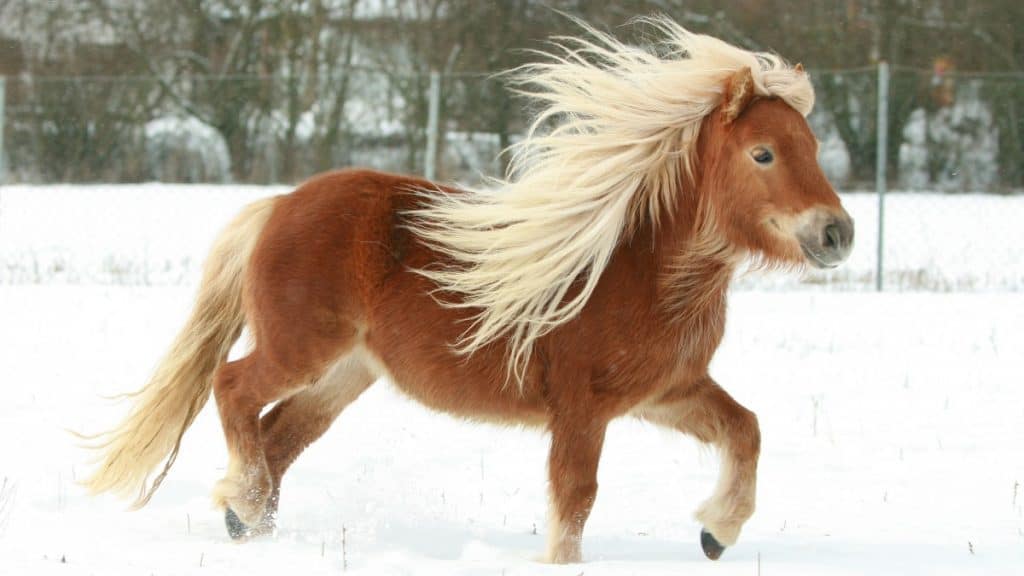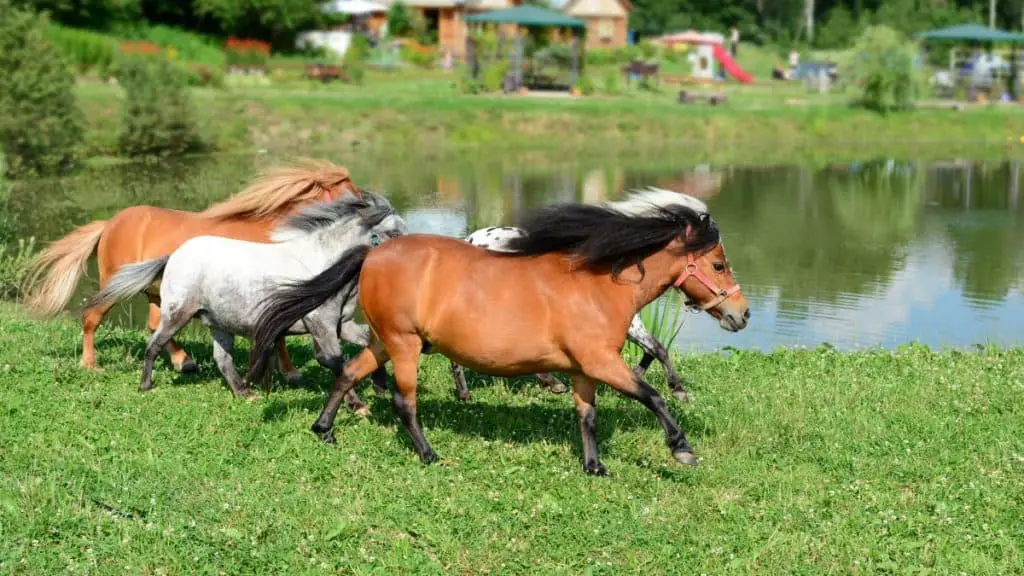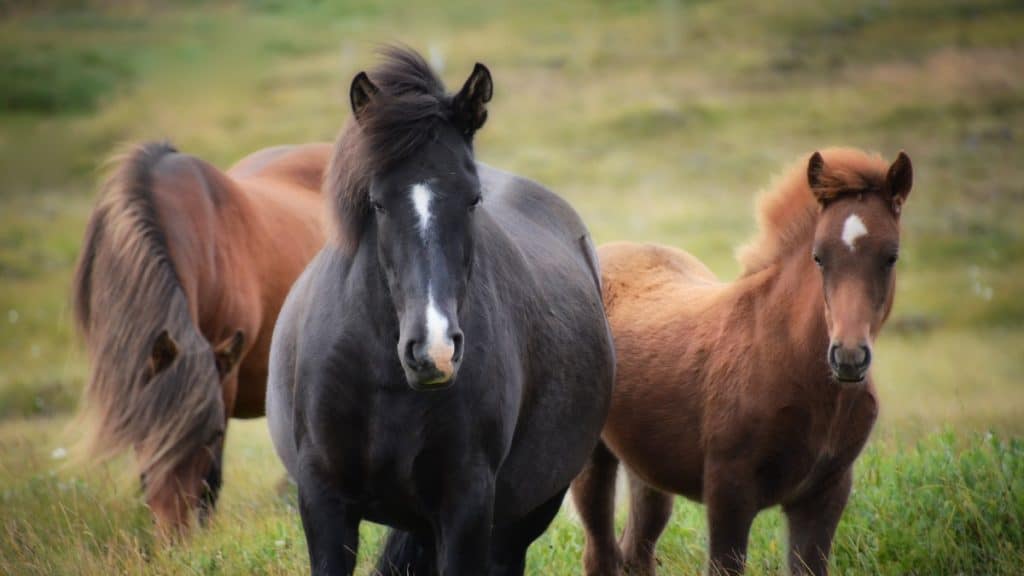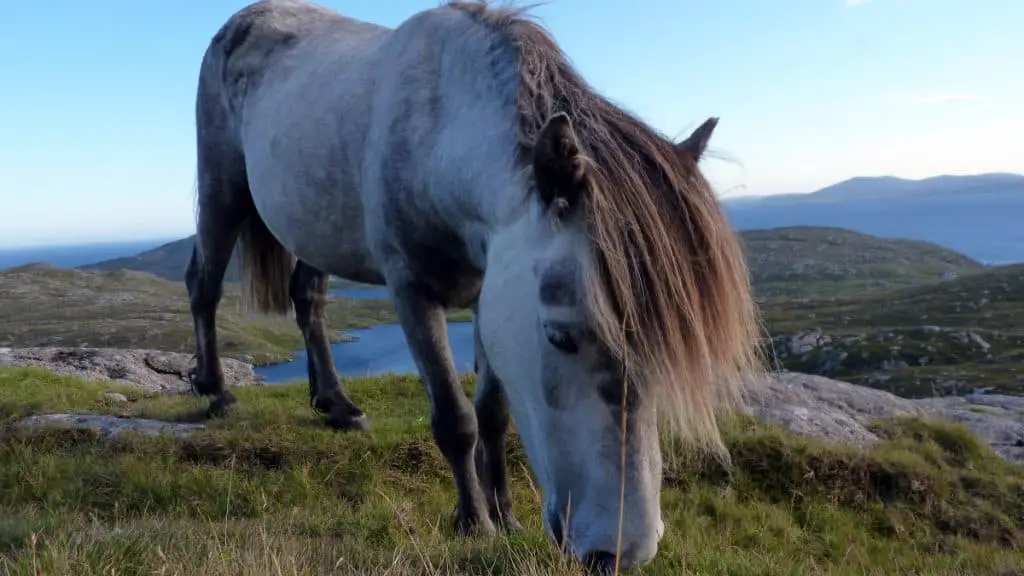Skip To Section
For the average person, a miniature horse or pony may appear to be the same thing. While they are both adorable at roughly 40 inches or so, there are some distinctive differences. What exactly are these small horse breeds?
Oxford Dictionary describes the pony as a small horse breed of petite, stocky nature noted for their gentleness. And oddly, there is not a definition of miniature horses. So what is the deal?
Ponies are different from the full-sized horse because of their size and stature. They are slight, usually under 14.2 hands.
They have a thicker coat and mane than the horse. They are usually stockier, with short legs, a wide middle, and a fuller neck.
The miniature horse is bred to resemble a full-sized horse, in fun size, if you will. They are usually under 34 inches (often measured in inches rather than hands).
The mini horse is bred to be slightly more refined than the pony, its neck being long and flexible, with straight legs and a shorter back.
But don’t let these tiny beauties fool you, as some are said to be able to pull more than a draft horse!
The roles that both these animals played in history have influenced their current size, temperament, and appearance.
The earliest record of the mini horse dates back to 1650, where French King Louis XIV kept a zoo at the Palace of Versailles. He was said to have a tiny horse in his zoo.
Ponies have been in the wild in the United States since the 1600s, but they first appeared as domestic animals in the 1800s. They were used in coal mines and for agricultural work.
Both ponies and mini horses come in a variety of different breeds. There is a little wiggle room when classifying them; however, We’ve put together a list of the smallest horse and pony breeds on planet earth.
1. Shetland Pony

The Shetland Pony is more than likely the charming little one you may have had your first pony ride on. They are gentle and intelligent but also quite capable of working very hard.
Originating in the Shetland Isles of North Scotland, Shetland ponies were most likely influenced by the Celtic pony, which was brought to the island between 2000 and 1000 BCE.
These rugged ponies roamed about the unforgiving islands off of Scotland and were more than likely figured into breeding the Shetland, with possible crosses of the Norse Settler.
Scotland’s harsh climate developed them into the hardened animals they are today. They were used to plow farmland, pull carts, and used during the industrial revolution in the coal mines.
These little beauties stand at a maximum of 10.5 hands at the withers, and in the United States, it’s little more than that at 11.5 hands. They usually weigh between 400 to 450 pounds.
The Shetland has a small head and tiny, alert ears. She sports a short neck, stocky body, and short legs.
Her little broad back and wide girth are common characteristics. Her long thick hair and double winter coat are made to withstand frigid temperatures. Because of the harsh climate of native Scotland, the Shetland has developed into hardy creatures.
The Shetland has been known to pull more weight than a draft horse! So these little guys have amazing strength in that tiny body. They also have a very long lifespan, close to 30 years, with few health problems.
The Shetland dazzles us with almost every color in the equine rainbow. They can be blessed with a pinto look, with white patches mixed with other colors, or be wholly brown, black, or chestnut. They have also been seen in palomino, cream, and buckskin.
Shetlands are generally good-natured, but they have been known to be rather opinionated. They are very intelligent, which can hinder you if you aren’t used to working with them.
They can be a bit cheeky and fairly confident when taking advantage of a certain situation.
Today, the Shetland is used primarily used by children, ridden both for pleasure and show. They have been used in zoos and carnivals. They have also been trained as guide horses, filling the same role as guide dogs.
2. Welsh Pony

The Welsh pony and cob have a long history with many challenges. But the result is a tough little animal with beautiful markings that makes him very popular amount children and small riders.
The Welsh Mountain Pony was developed in Wales around 1600 BC, existing in a partly feral state, wandering the mountains over Welsh terrain. They are believed to have been bred by crossing native ponies with the Arabian.
The Welsh Pony developed into a hardy breed because of the frigid climate, along with little access to food or shelter. Generations of exposure to Britain’s environment have made them extremely adaptable.
The Welsh Ponies we see today existed as early as the Middle Ages and have been mentioned throughout Welsh literature. In 1485, they assisted the Welsh militia along with Henry VII in claiming the English throne.
The breed arrived in the United States in the late 19th century, and their population continues today.
Welsh ponies and cobs fit into four different classifications. Section A is the foundation of the breed, standing at just 12 hands.
Section B is between 12 and 13.2 hands, Section C is the cob and has more bone structure than the others. They stand up to 13.2 hands. Section D is the largest, also a cob, and can be up to 15 hands high.
The Welsh pony is identifiable by its strong hindquarters and short backs. They have large, expressive eyes and luxurious tails with thick hair.
The pony and cob come in several colors, the most common being gray, black, or bay. They have also been seen in cream, palomino, or roan, giving them a mix of colored and white hair.
They have an excellent temperament which works in their favor if they are competing. They are also quite spirited and intelligent.
Trail riding on the Welsh Pony through the United States or the United Kingdom is common today. They are also used in dressage competitions, and their small size makes them perfect for children.
3. The Noma Pony
The Noma is a breed of small horses from the Japanese island of Shikoku. Unfortunately, they are critically endangered. It is believed that there are less than 100 Noma Horses alive today!
They may have been used in the 16th century by the feudal lord, Iyo-Matsuyama Han, for military purposes. The Noma is thought to be derived from horses used as pack animals on steep terrain.
The Noma is a small and sturdy horse that is powerful and energetic. They are the tiniest of the Japanese native horse breeds, being an average of 10.75 hands and about 450 pounds.
They have a cylindrical body, round buttocks, and thin legs. They are mostly seen in solid colors such as white or brown, and their manes are more straight like a horse, and their hair is on the short side.
They are known to have calm temperments and will easily work with children.
4. Falabella Horse

This breed is one of the smallest horse breeds, developed in 1868. This horse originated from Argentina. The Falabella is part Welsh Pony and Shetland Pony, as well as smaller thoroughbred. She is named after the Falabella family, which purposely bred smaller breed horses.
The modern standard measures about 34 inches at the withers. They are similar to thoroughbreds as they have a sleek coat and a slim frame. Their body is small and compact with a thick coat, mane, and tail.
Her head is slightly larger than her neck. Brown and black are the most common colors, but they can also be found in spotted patterns such as pinto or palominos.
Falabellas are known to have a mild temperament and do especially well around children. They are great for pony rides, competitions, or shows. They do very well on a large farm or fenced-in area.
They make exceptional pets as they are so well-mannered and adore children. They have also been used as therapy horses due to their diminutive size and trainability.
Notorious for being sweet, these horses are an easy decision if wondering what type of small horse to add to the family. They welcome affection from adults and children, two fantastic qualities ideal for any horse owner.
5. Ponies of America (POA)
These adorable tiny breeds are derived from the Shetland Pony but were further developed in the state of Iowa after coming to America. The foundation stallion was a cross between an Arabian, Appaloosa, and Shetland Cross, which made a beautiful spotted pony.
The breed can now be found in Minnesota, Kansas, Missouri, Nebraska, Illinois, and other states in the midwest. They were originally bred for Western riding and showing and are still popular in that genre, as well as English riding.
Breed characteristics are not overly strict, but there are restrictions on height, as they must be between 11 to 13 hands with a quarter horse body and an Arabian-style face.
They tend to have a white area that encircles the dark iris of the eye. This is considered a characteristic of the breed when it’s not against a bald face. Some of these horses also have clearly defined vertical stripes on their hooves.
They are very smart and have a calm and giving disposition. They are also very easy to train.
They are fairly hardy and easy to take care of and will develop great loyalty to their families, as they make excellent pets. These smaller horses are happy being kept on farms and small enough for pony rides for children.
6. Icelandic Horses

These tiny horses are found mostly in Iceland and are well known for being easy to care for.
These are some of the only breeds that had not been altered since they were created. Many other breeds of horses have other bloodlines introduced throughout time as breeders aim to perfect the breed. But in over 800 years, there have never been any outside bloodlines introduced to the Icelandic Horse.
They were primarily used by the Vikings and have completed tasks such as transporting people and swimming through the deep glaciers present in the country.
When fully grown, they stand at around 14 hands and have sloping shoulders and strong legs. They are full of muscle and can be found in almost any color.
Their hair is thick and gives great protection against the harsh climate of Iceland. Their mane and tail are often thick and coarse.
They have lovely dispositions and are easy to ride. They do exceptionally well with small children and a favorite for pony rides due to their calm manner.
They have become very popular outside of their native land because they are so easygoing. Because they are so tiny, they are often treated as family members and given a relaxed life, which has undoubtedly contributed to their gentle nature.
Throughout Iceland today, you can find the Icelandic pony grazing or playing with the herd. They are tough little horses and can adapt to tough situations, but they are also very loving and gentle.
If visiting Iceland, you will find them in many programs for tours through the country. You may be surprised how small they are when you sit on one, but they are more than happy to spend a day trekking through the highlands of Iceland with a person in tow.
7. The Boer Pony
These little ponies come from South Africa, where they lived on the Cape Provinces. The Boer pony is known for its keen hunting ability, as well as being able to notify its owners of any danger.
This breed is surefooted and has been known to carry men as they were used as workhorses. They are a combination of the Cape Horse and the Basuto Pony and also go by the name “the farmer’s horse.”
The Boer Pony was almost extinct in the late 19th century due to an illness that swept through the land.
She stands at around 15 hands when she is full-grown, with strong shoulders and joints, with a short back. They are usually seen in the traditional colors, bay, black, grey, or palomino.
The Boer pony is sweet and gentle around children and very eager to please its owners. They are quick to learn and willing to work.
She is strong with the ability to carry people for hours without getting tired.
8. Eriskay Pony

The Eriskay pony is one of the last breeds to come from the Celtic Pony. They originated from the British Isles and received their name from the Eric’s Isle, or Eriskay, located in Scottland.
Crofters were fond of this breed, as they were ideal as farm horses and for transportation for children. The Eriskay is used to hauling heaving loads, and they are acclimated to hard weather.
Due to cross-breeding, the breed was at risk of becoming extinct.
The Eriskay stands between 12 and 13.2 hands but is very strong for its petite size. He stands with a large head but fairly small feet.
Muscular shoulders and a powerful back are part of what makes this breed so hardy. These little-sized horses hold their heads high and very workmanlike, and their tail usually sits low to protect from wind and rain.
They have a dense waterproof coat which is ideal for the harshest of conditions. They are generally gray, black, and brown with a tapered muzzle.
These horses can be left unattended with children with almost no worry. They are very gentle and easily adaptable to changing conditions.
They make excellent drive ponies and have been known to compete at the FEI level. They make excellent pets as their friendly personality is wonderful with children.
They are happy in any climate but fair especially well in the cold rainy weather of Scotland.
9. Fell Pony

These ponies, which share their origin with the extinct Galloway Pony, originated from the English Scottish border and are believed to have pre-dated the Romans.
This working breed with stamina and intelligence has been able to thrive in the harsh conditions of the Fells in the Lake District of Northern England. They were used as packhorses, where they carried lead, copper, and iron.
They were also used for the transportation of farm goods. The Fell pony was a favorite of the Vikings as packhorses, as well as being used for plowing and pulling sleds.
They were also used as pack ponies into the 20th century by the postal service to cover large areas with quick speed.
The average height of the Fell Pony is about 13.2 hands, and she can be found in black, brown, grey, and chestnut, sometimes with a star on the head and white below the hind fetlock.
Intelligence and self-preservation come naturally to this breed as it is a common trait among them and the Moorland Pony. The Fell ponies are lively with a spunky attitude and a calm temperament.
They are agile jumpers and also do well at country riding and hunting.
I hope this list has been helpful for you, and I trust it has taught you a lot!
